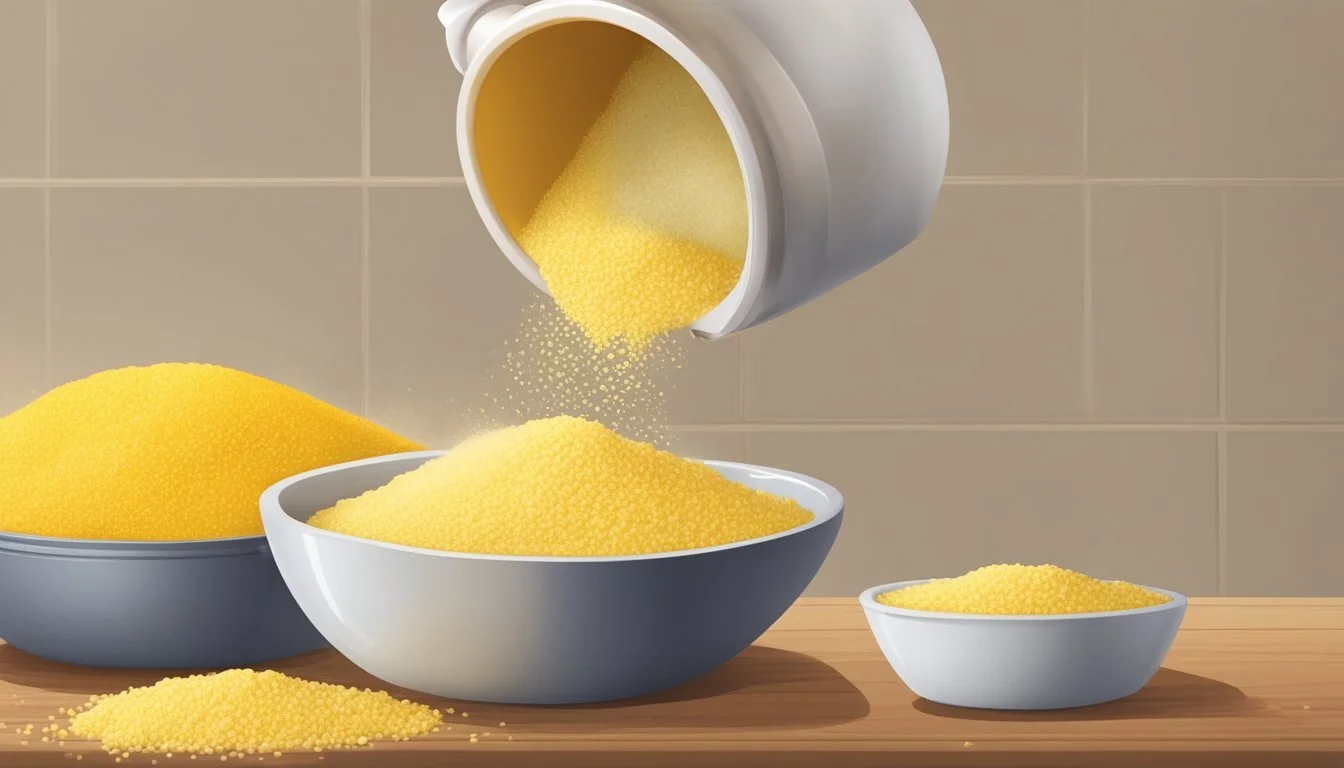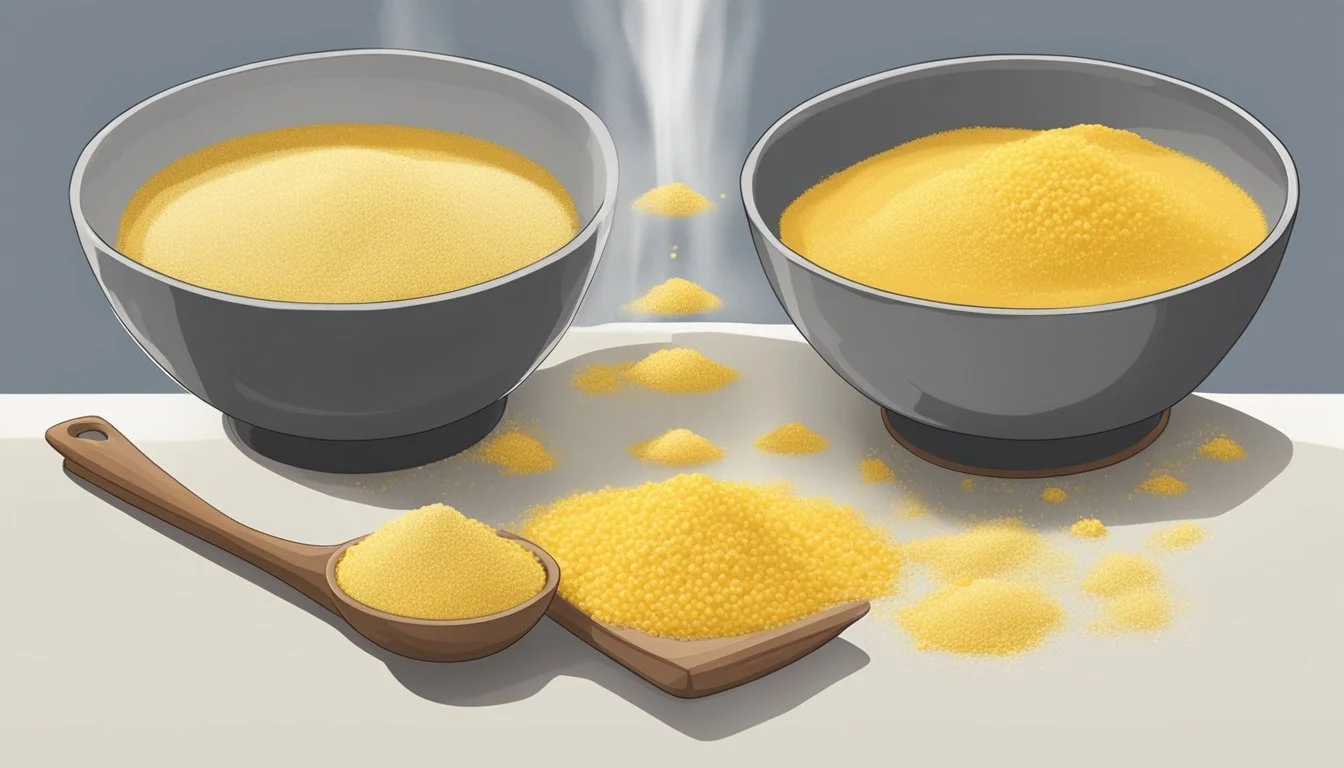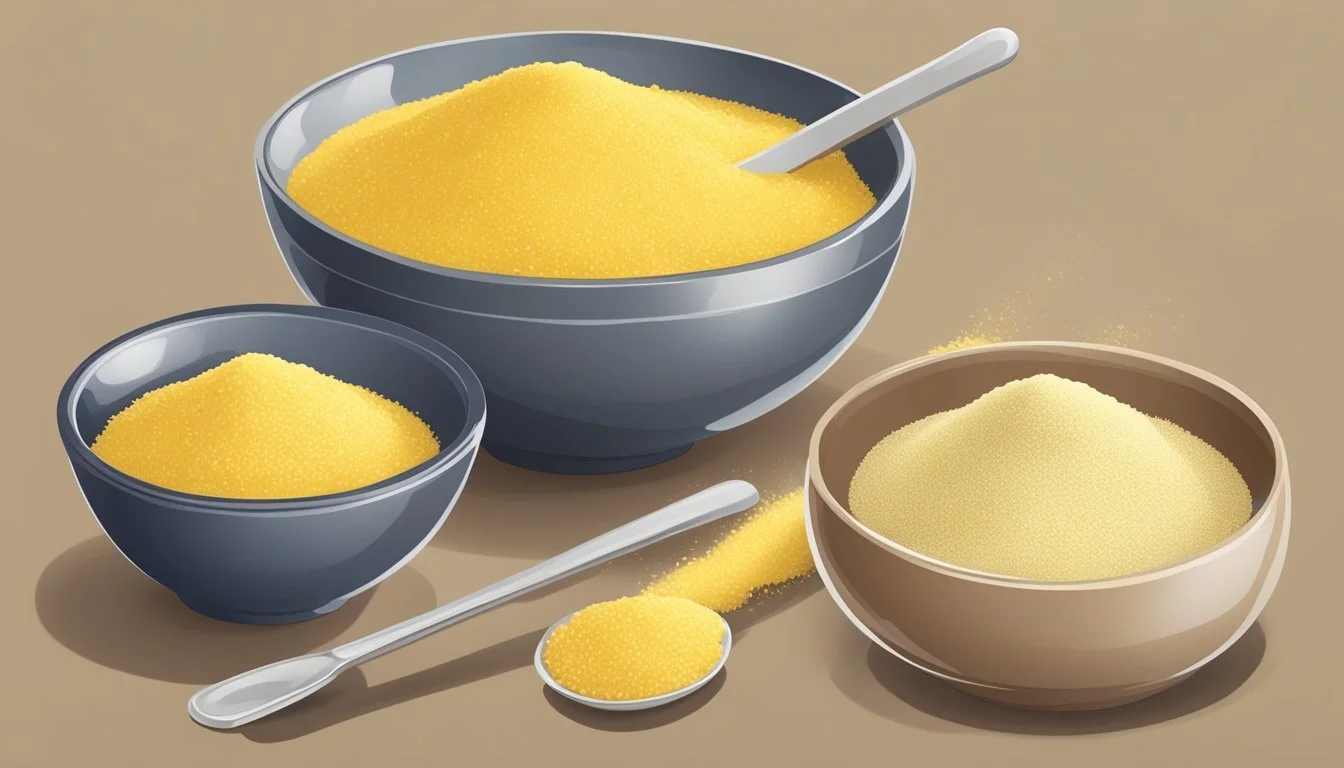How to Substitute Yellow Cornmeal for White Cornmeal
Simple Swaps for Your Recipes
Cornmeal, a staple ingredient derived from dried maize, is a foundational element in both savory and sweet dishes around the globe. When recipes specify the type of cornmeal to use, they usually mention either white or yellow cornmeal, as these are the two most common varieties. Regardless of color, the primary difference in cornmeal lies in the type of corn from which it is ground.
White cornmeal is made from white corn and is commonly used in recipes for a lighter, more delicate texture, while yellow cornmeal, derived from yellow corn, tends to give a richer color to dishes with a slightly different flavor profile. However, in terms of cooking and baking properties, white and yellow cornmeal are largely interchangeable. It is important to note the grind's coarseness, which can vary in both types and affect the final texture of the cooked product.
In terms of texture and consistency, both white and yellow cornmeal can be utilized to deliver a satisfying crunch or to thicken mixtures like soups, stews, and sauces. When substituting yellow cornmeal for white, cooks can expect a similar performance in their recipes, making the swap a matter of personal preference or availability. By paying attention to grind coarseness and potential slight variations in flavor, one can confidently use yellow cornmeal in place of white for a successful culinary outcome.
Understanding Cornmeal Varieties
Cornmeal, derived from dried corn, comes in different varieties, most notably white and yellow. These varieties differ mainly in color and texture, directly influencing their nutritional values and culinary uses.
Colour Differences and Nutritional Value
White cornmeal is made from white corn and yellow cornmeal from yellow corn. The primary difference in color stems from the presence of beta carotene in yellow corn, which imparts the grain’s hue and converts to vitamin A in the human body. As a result, yellow cornmeal holds a higher vitamin A content.
White cornmeal: Typically lower in beta carotene.
Yellow cornmeal: Contains beta carotene, hence higher in vitamin A.
Textural Discrepancies and Culinary Uses
The texture of cornmeal varies from fine to coarse, affecting its application in cooking and baking. White cornmeal is often milled to a finer grind than its yellow counterpart, leading to a more delicate and refined texture ideal for baked goods like white cornbread. Conversely, yellow cornmeal's coarser grind lends a rustic texture that suits dishes like polenta or cornbread with a heartier feel.
Fine grind: Suited for delicate, less-crumbly baked goods.
Coarse grind: Better for robust, textured dishes.
Basic Substitution Principles
When substituting yellow cornmeal for white cornmeal in recipes, it is crucial to maintain a consistent texture and flavor profile that the dish requires. Adjustments may need to be tailored based on the desired outcome, whether it's for cornbread, muffins, or any other recipe where cornmeal is a key ingredient.
Direct Ratios for Substituting Yellow for White Cornmeal
Cornmeal is a staple in many kitchens and is widely used for its ability to provide structure and a sweet flavor to dishes. When it comes to substituting yellow cornmeal for white cornmeal, the process is rather straightforward:
1:1 Ratio: Yellow and white cornmeal can typically be swapped at a 1:1 ratio, meaning if a recipe calls for 1 cup of white cornmeal, one can use 1 cup of yellow cornmeal without affecting the texture of the dish.
The major difference lies in the color. Yellow cornmeal will impart a golden hue to the recipe, which may be visually apparent in lighter dishes.
Cornbread and muffins made with yellow cornmeal may also have a slightly more pronounced sweet flavor and a heartier aroma.
Adjusting for Flavor and Color
While the texture remains consistent when using yellow cornmeal as a substitute for white, there are slight variances in flavor and color that should be considered:
Flavor Profile: Yellow cornmeal often has a unique flavor that is somewhat sweeter than white cornmeal. This could enrich the dish but may be noticeable in delicately flavored recipes.
Visual Impact: The vibrant yellow color of yellow cornmeal adds a warm tone to the finished product, which could be a visual cue for those accustomed to the paler appearance of dishes made with white cornmeal.
For the most seamless substitution, these factors should be taken into account to ensure the final dish meets the expectations of both taste and visual appeal.
Effects of Cornmeal Substitution in Various Recipes
The substitution of yellow cornmeal for white cornmeal can lead to nuanced differences in flavor and minor variations in texture across various dishes. It is important for cooks and bakers to understand how these substitutions might affect the outcome of their recipes.
Cornmeal in Baked Goods
In baking, cornmeal is often a key ingredient in recipes such as cakes, corn muffins, pastries, and johnnycakes. Yellow cornmeal generally imparts a stronger, sweeter flavor compared to the milder taste of white cornmeal. Here are some specifics:
Cakes and Pastries: Yellow cornmeal can add a golden hue and a more pronounced corn flavor, which might be desirable in certain recipes like cornbread or corn muffins. If a recipe calls for white cornmeal and only yellow is available, it can be used without significant structural changes, though the final product will exhibit these slight taste and color differences.
Corn Muffins and Johnnycakes: In these recipes, the granularity of the cornmeal can affect the texture. A finer grind results in a tender crumb, while a coarser grind yields a heartier, more rustic bite. Whether using yellow or white cornmeal, maintaining the same grind size as the recipe specifies is key for preserving the intended texture.
Savory and Other Specialty Dishes
Cornmeal is not just for sweets and bread; it is also integral to many savory dishes, such as polenta, grits, tortillas, and hushpuppies. The difference between yellow and white cornmeal in these cases can affect both presentation and taste.
Polenta and Grits: These dishes rely heavily on the flavor of the cornmeal itself. Swapping white for yellow cornmeal in grits or polenta will impart a slightly different flavor profile and a richer color. Texture-wise, the substitution should not pose any issues, provided that the grind size is consistent.
Tortillas and Hushpuppies: When making tortillas, the type of cornmeal can influence the pliability and taste. Yellow cornmeal might create a slightly sweeter tortilla, which could complement certain fillings. In hushpuppies, the use of yellow over white cornmeal could result in a more robust flavor, pairing well with the dish’s savory elements.
Incorporating yellow cornmeal in place of white cornmeal requires some consideration of these factors to ensure that the final dish meets the cook's or baker's expectations.
Dealing with Texture Variations
When substituting yellow cornmeal for white cornmeal, the texture is an important consideration. The grind of the cornmeal, whether fine or coarse, can significantly affect the final texture of a dish.
Fine Versus Coarse: Matching Textures
Yellow and white cornmeal can be found in both fine and coarse grinds. Fine cornmeal will lend a smoother texture to dishes, while coarse cornmeal provides a more rustic feel with a grittier texture.
When a recipe calls for fine cornmeal and only coarse is available:
Try sifting the coarse cornmeal. This may remove larger granules, mimicking a finer texture.
Consider the intended use—baked goods like cornbread may accommodate slightly coarser textures without much difference in the end product.
Conversely, if coarse cornmeal is needed and only fine is at hand:
Look for pre-packaged “coarse ground” labelled products to avoid further kitchen adjustments.
Acknowledge that dishes expecting a textured crunch, like polenta, may have a different mouthfeel with finer cornmeal.
Using a Food Processor for Custom Grind
In the absence of the desired texture, a food processor becomes a versatile tool in the kitchen to achieve the preferred grind of cornmeal.
To create a finer grind using a food processor:
Measure the needed amount of coarse cornmeal.
Pulse in short bursts to gradually approach a finely ground consistency, checking frequently to avoid over-grinding.
To transform fine cornmeal to a coarser texture:
One may have to accept that a food processor might not effectively recreate a naturally coarse grind.
Instead, blending fine cornmeal with a smaller amount of a coarser flour may improve texture without the need for processing.
By using these methods, one can gain control over the texture of cornmeal, ensuring the right consistency for a variety of culinary applications. It is essential to adjust and test as necessary, as substitutions can alter outcomes in texture-driven recipes.
Alternative Ingredients and Gluten-Free Options
When substituting yellow for white cornmeal, one has access to an array of alternative flours and gluten-free options that cater to different dietary needs while maintaining the desired texture and flavor in recipes.
Incorporating Non-Cornmeal Flours
For those seeking to replace yellow cornmeal without using another type of cornmeal, various flours can serve as adequate substitutes. Wheat flour is a common go-to that replicates the texture of cornmeal, although it lacks the distinct corn flavor and is not gluten-free. To closely mimic the consistency of cornmeal in batters and coatings, one can opt for rice flour which offers a fine texture. It should be noted that rice flour imparts a more neutral flavor.
Substitute ratios for non-cornmeal flours:
Wheat Flour: Use a 1:1 ratio when substituting for cornmeal.
Rice Flour: Also use a 1:1 ratio; perfect for achieving a lighter texture in baked goods.
Navigating Dietary Restrictions
Individuals with gluten intolerance or a corn allergy can consider several gluten-free flours as alternatives to cornmeal. Rice flour is an excellent choice, bearing the advantage of being gluten-free and having a fine texture that works well for thickening mixtures. Additionally, corn flour, while still derived from corn, is a more finely ground option and also gluten-free, though not suitable for those with a corn allergy.
Gluten-free and corn allergy-friendly substitutes:
Rice Flour: Gluten-free and a versatile thickener, ideal for soups and sauces.
Corn Flour: Gluten-free but not suitable for those with corn allergies, use it as a direct replacement for cornmeal.
These alternatives provide flexibility for those with dietary restrictions while ensuring the integrity of recipes that traditionally require yellow or white cornmeal.
Homemade Substitutes for Commercial Cornmeal
When commercial yellow cornmeal is unavailable or if a home cook prefers a more hands-on approach, there are viable options for creating substitutes within a typical kitchen setting. These alternatives can closely mimic the texture and versatility of store-bought cornmeal.
Making Your Own Cornmeal at Home
Homemade Cornmeal: A method for creating cornmeal involves selecting dried corn—yellow or white, depending on the recipe preference—and grinding it to the desired coarseness. A food processor, high-powered blender, or grain mill can be utilized for this purpose, and the process can be adjusted to make the cornmeal as fine or as coarse as needed. Kernel selection is vital, and one should look for drying or popping corn varieties suited for grinding.
Drying Corn: If the cook starts with fresh corn, they should dehydrate the kernels first. This can be done by cooking the corn slightly less than usual, then cutting it off the cob. The kernels are spread on a dehydrator tray and dried until brittle. Afterwards, they are ground to make cornmeal.
Grinding Equipment: Kitchen devices capable of grinding corn include:
Kitchen Device Coarseness Level Food Processor Medium to Coarse High-powered Blender Fine to Medium Grain Mill Varied, stone-ground quality
Blending Other Grains and Seeds
For those seeking a substitute due to dietary restrictions or lack of corn, other grains and seeds can be ground to replace cornmeal. Using a blender or food processor, ground oats or ground flaxseed can offer a similar consistency. These substitutes might alter the flavor profile but can still provide the binding quality necessary for recipes that call for cornmeal.
Grain Substitutes:
Substitute Texture Similarity Note Oats (ground) Similar to medium-grind cornmeal Mild taste, may lighten the final product Flaxseed (ground) More granular, absorbs more liquid Adds a nutty flavor, boosts nutritional content
Thickeners and Binders: Other than grinding grains, cornflour and cornstarch can act as thickeners in sauces, whereas breadcrumbs can add texture in recipes like coatings and toppings that usually utilize cornmeal. These options will not provide an identical cornmeal experience but serve as functional alternatives within recipes.
Cultural and Historical Context
Cornmeal has played a fundamental role in various cuisines for centuries, with distinct variations like white and yellow cornmeal forming the backbone of numerous traditional dishes. Each variety has deep historical roots and their use can reflect cultural identities.
Cornmeal Usage in Different Cuisines
In the Southern states of the U.S., cornmeal, particularly white cornmeal, is integral to creating the region's signature cornbread. Tradition often pairs this staple with a variety of dishes, such as chili and collard greens (how long do collard greens last?). Meanwhile, in parts of Africa and Latin America, white cornmeal is favored for its milder flavor, often used in the preparation of dishes like arepas and ugali.
Northern Italy brings its take with polenta, traditionally made from yellow cornmeal. Its role in Italian culinary history is notable, serving as an essential and accessible staple for many, particularly in the colder, alpine regions where wheat was less common.
Historical Significance of Cornmeal Varieties
The history of cornmeal is as rich as its culinary applications. Native Americans introduced corn, and subsequently cornmeal, to European settlers, who then incorporated it into their own diets. The type of cornmeal used could sometimes indicate social and economic status; finer grinds were more labor-intensive and thus more expensive, pointing to higher social standings.
As time progressed, names and cooking methods evolved — johnnycakes, spoonbread, and the like emerged. But the historical context remained; cornmeal is a food born of necessity, adaptability, and cultural interchange. Its use in kitchens around the world today is a testament to its versatility and lasting cultural impact.
Shopping and Storage Tips for Cornmeal
When selecting cornmeal, one must consider the type and color that best suits their culinary needs. Proper storage is crucial for maintaining freshness and extending shelf life.
Selecting the Right Product at Stores
In grocery stores, shoppers typically encounter both yellow and white cornmeal. Yellow cornmeal, made from yellow corn, has a slightly sweet, robust flavor, while white cornmeal, made from white corn, is often milder. Both can be used interchangeably in recipes; however, they might impart a slight color difference to the final dish. When purchasing cornmeal, consider the varieties available, which may include fine, medium, or coarse grains, each lending a different texture to recipes.
Fine-grained cornmeal yields a smoother consistency.
Coarse-grained cornmeal offers a heartier texture.
Proper Storage Practices
To ensure that cornmeal retains its quality over time, follow these storage guidelines:
Store cornmeal in a cool, dry place away from direct sunlight.
Transfer cornmeal to an airtight container to protect it from moisture and pests.
For extended shelf life, cornmeal can be refrigerated or frozen, where it can last for about a year.
By selecting the product carefully and adhering to proper storage practices, one ensures that their cornmeal remains fresh, preserving its flavor and texture until its next use.







